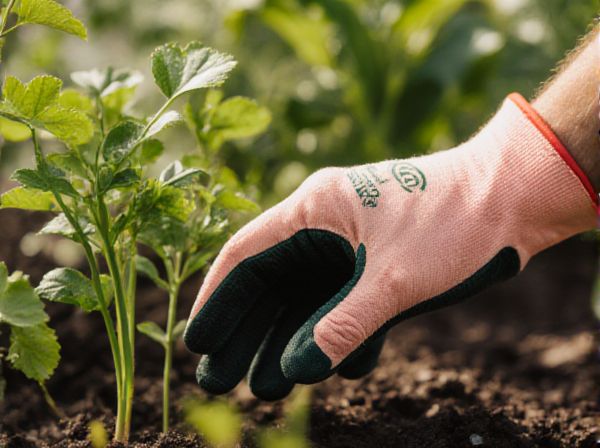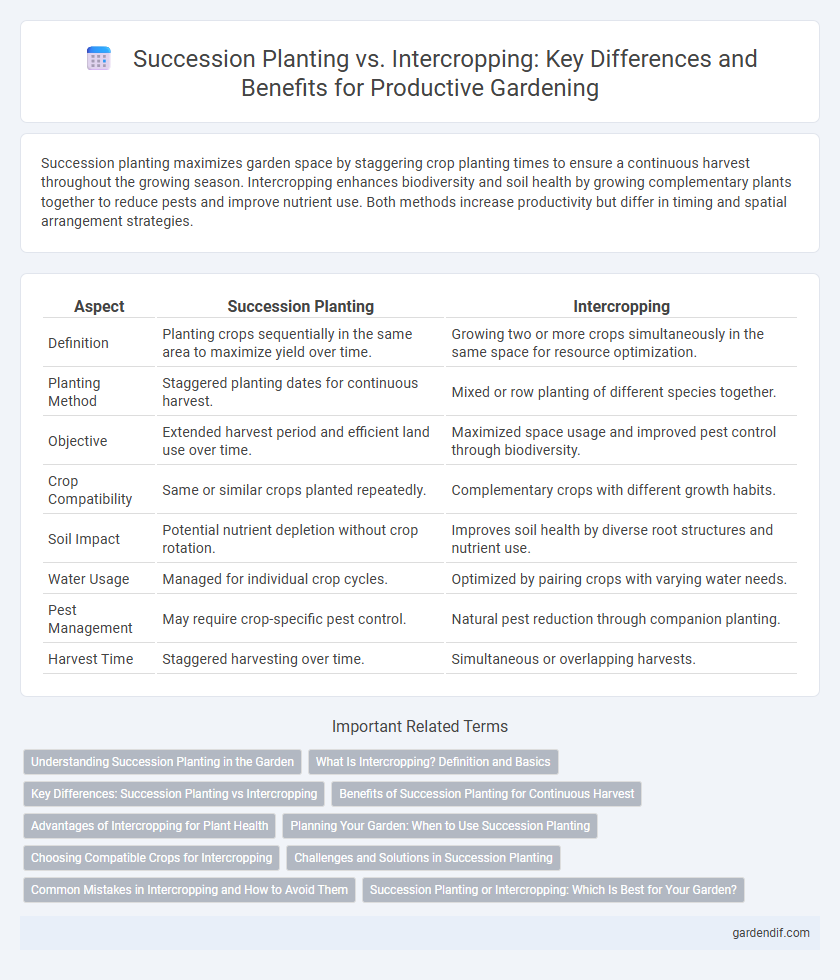
Succession planting vs Intercropping Illustration
Succession planting maximizes garden space by staggering crop planting times to ensure a continuous harvest throughout the growing season. Intercropping enhances biodiversity and soil health by growing complementary plants together to reduce pests and improve nutrient use. Both methods increase productivity but differ in timing and spatial arrangement strategies.
Table of Comparison
| Aspect | Succession Planting | Intercropping |
|---|---|---|
| Definition | Planting crops sequentially in the same area to maximize yield over time. | Growing two or more crops simultaneously in the same space for resource optimization. |
| Planting Method | Staggered planting dates for continuous harvest. | Mixed or row planting of different species together. |
| Objective | Extended harvest period and efficient land use over time. | Maximized space usage and improved pest control through biodiversity. |
| Crop Compatibility | Same or similar crops planted repeatedly. | Complementary crops with different growth habits. |
| Soil Impact | Potential nutrient depletion without crop rotation. | Improves soil health by diverse root structures and nutrient use. |
| Water Usage | Managed for individual crop cycles. | Optimized by pairing crops with varying water needs. |
| Pest Management | May require crop-specific pest control. | Natural pest reduction through companion planting. |
| Harvest Time | Staggered harvesting over time. | Simultaneous or overlapping harvests. |
Understanding Succession Planting in the Garden
Succession planting maximizes garden productivity by staggering planting times to ensure continuous harvests throughout the growing season. This technique involves planting a new crop immediately after harvesting the previous one, effectively utilizing garden space and soil nutrients in a sequential manner. Understanding the timing and crop compatibility is essential for optimizing yields and maintaining soil health in succession planting systems.
What Is Intercropping? Definition and Basics
Intercropping is an agricultural practice where two or more crops are grown simultaneously on the same field to maximize space, improve soil health, and reduce pest pressure. This method enhances biodiversity and can lead to higher overall yields by optimizing the complementary interactions between different plant species. Key types of intercropping include row intercropping, mixed intercropping, and strip intercropping, each designed to suit specific crop combinations and field layouts.
Key Differences: Succession Planting vs Intercropping
Succession planting involves growing crops in a planned sequence to maximize harvest over a season, while intercropping entails growing two or more crops simultaneously on the same land to optimize space and resources. Succession planting enhances soil recovery and pest control by staggering plant growth, whereas intercropping improves biodiversity and reduces weed pressure through complementary plant interactions. Both methods increase yield efficiency but differ in timing, spatial arrangement, and crop diversity management.
Benefits of Succession Planting for Continuous Harvest
Succession planting maximizes garden productivity by staggering crop planting times, ensuring a continuous harvest throughout the growing season. This method reduces gaps in production, allowing for steady supply of fresh vegetables or herbs, which is especially beneficial for home gardeners and commercial growers seeking consistent yields. Compared to intercropping, succession planting simplifies crop management by focusing on sequential planting of single crops, enhancing soil nutrient use efficiency and minimizing pest and disease buildup.
Advantages of Intercropping for Plant Health
Intercropping enhances plant health by improving biodiversity, which reduces pest and disease outbreaks through natural predator attraction and habitat diversity. This practice increases soil nutrient availability and moisture retention by combining complementary root structures and nutrient needs, promoting healthier growth. The continuous ground cover provided by intercropping also minimizes soil erosion and suppresses weeds, contributing to a more resilient and sustainable plant ecosystem.
Planning Your Garden: When to Use Succession Planting
Succession planting maximizes garden productivity by staggering crops in intervals to ensure continuous harvest throughout the growing season. It is ideal for planning when space is limited and specific crops like leafy greens or root vegetables mature quickly and can be replaced repeatedly. Using succession planting strategically complements intercropping by focusing on time-managed crop rotation rather than simultaneous planting.
Choosing Compatible Crops for Intercropping
Choosing compatible crops for intercropping involves selecting plant species with complementary growth habits, nutrient requirements, and pest resistance to maximize space and resource efficiency. For example, pairing deep-rooted plants like carrots with shallow-rooted crops such as lettuce reduces nutrient competition and enhances overall yield. Crop compatibility ensures balanced shading, prevents allelopathy, and supports soil health, making it a crucial factor in successful intercropping systems.
Challenges and Solutions in Succession Planting
Succession planting faces challenges such as soil nutrient depletion, increased pest and disease pressure, and timing complexities for optimal crop growth. Solutions include crop rotation to maintain soil fertility, integrated pest management to reduce infestations, and careful scheduling based on crop maturity rates to ensure continuous harvests. Employing cover crops and organic amendments further enhances soil health and supports sustainable succession planting practices.
Common Mistakes in Intercropping and How to Avoid Them
Common mistakes in intercropping include poor plant compatibility, improper spacing, and neglecting soil nutrient requirements, which can lead to reduced yields and increased pest issues. Avoid these errors by carefully selecting complementary crops based on growth habits, ensuring adequate spacing to minimize competition, and maintaining balanced soil fertility through targeted fertilization. Monitoring crop health regularly and adjusting planting patterns according to season-specific conditions also improves overall productivity in intercropping systems.
Succession Planting or Intercropping: Which Is Best for Your Garden?
Succession planting maximizes garden yield by staggering crops throughout the growing season, ensuring continuous harvests and optimal use of space. Intercropping enhances biodiversity and pest control by growing complementary plants together, improving soil health and resource efficiency. Choosing between succession planting or intercropping depends on garden size, crop variety, and desired maintenance level for optimal productivity.
Succession planting vs Intercropping Infographic

 gardendif.com
gardendif.com